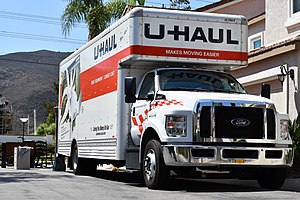
The U-Haul lesbian or U-Haul syndrome is a stereotype of lesbian relationships referring to the idea that lesbians tend to move in together after a short period of time (e.g., after the second date). It suggests an extreme inclination toward committed relationships. Depending on context, the term can be considered humorous, complimentary, or pejorative.
Origin
A joke which references U-Haul (a brand of self-move rental trucks and trailers) became well known in lesbian culture.
Question: What does a lesbian bring on a second date?
Answer: A U-Haul.
It is considered a staple of lesbian humor. It is often attributed to comic Lea DeLaria, who claimed in her 1997 comedy album, Box Lunch, that she had written it in 1989 — in the album, she gets the audience to yell back the punchline, showing it was already well-known at the time of recording.
Reference to a U-Haul later became a stereotype of sexual identity in the gay community. It is sometimes followed or preceded by a standard joke about gay men:
Question: What does a gay man bring on a second date?
Answer: What second date?
The joke is also popular outside the LGBTQ community.
Relationships
Psychologists note that the U-Haul joke epitomizes the perceived phenomenon of lesbians to form intense emotional connections, referred to in gay slang as an "urge to merge". Critics of this alleged tendency suggest that it is used by lesbians to avoid the risks involved with dating. In their view, an aversion to the risks of dating is linked to a stunted development of intimate relationships during the teenage years when most gays and lesbians are in the closet. With the freedom of adulthood, lesbians become drawn to U-Haul relationships, appreciating their intensity and intimacy.
Some psychologists also believe that this behavior can be unhealthy. They argue that the short dating-span bypasses serious discussion on many relationship issues prior to moving in (such as sexual compatibility or future expectations) and this can manifest itself in various problems later on.
See also
- Cohabitation
- Commitment bands
- Domestic partnership
- Gay bars
- Gay community
- Gay slang
- Lesbian bed death
- Queer studies
- Same-sex marriage
References
- Eliason, Michele J. (26 October 2010). "A New Classification System for Lesbians: The Dyke Diagnostic Manual". Journal of Lesbian Studies. 14 (4): 401–414. doi:10.1080/10894161003677133. PMID 20661801. S2CID 205754307.
- Gordon, Liahna E. (April 2006). "Bringing the U-Haul: Embracing and Resisting Sexual Stereotypes in a Lesbian Community". Sexualities. 9 (2): 171–192. doi:10.1177/1363460706063118. S2CID 145353805.
- Alexander, Christopher J., ed. (1996). Gay and Lesbian Mental Health: A Sourcebook for Practitioners (1st ed.). New York: Haworth Park Press. p. 98. ISBN 978-1560238799. LCCN 95043392. OCLC 33948761.
- Queen, Robin (2005). ""How Many Lesbians Does It Take...": Jokes, Teasing, and the Negotiation of Stereotypes about Lesbians". Journal of Linguistic Anthropology. 15 (2): 239–257. doi:10.1525/jlin.2005.15.2.239. ISSN 1055-1360. JSTOR 43104051.
- Bing, Janet; Heller, Dana (2003). "How many lesbians does it take to screw in a light bulb?". International Journal of Humor Research. 16 (2): 157–182. doi:10.1515/humr.2003.009. ISSN 1613-3722.
- Kelleher, Kathleen (January 31, 2000). "Couple's Emotional Bonding Can Take the Steam Out of Intimacy". LA Times.
- Brown-Scott, Jo Ann (July 2007). Epiphany and Her Friends: Intuitive Realizations That Have Changed Women's Lives. BookSurge. p. 339.
- ^ Lea DeLaria (1997). ""Empty Bed Blues" (the not-so-straight-ahead version)". Box Lunch (Audio CD). Rising Star Records. 6:10 minutes in.
I had a girl, and I figured after seven days I could trust her, so I moved her into my house. Typical lesbian relationship, huh, women? As perfectly exemplified by the joke I wrote in 1989. Everybody: what does a lesbian bring on a second date? What does a gay man bring on a second date? What second date?
- ^ Denizet-Lewis, Benoit (2008-04-27). "Young Gay Rites". The New York Times Magazine. Archived from the original on 2019-12-24. Retrieved 2008-04-28.
- Alexander, Christopher J., ed. (1996). Gay and Lesbian Mental Health: A Sourcebook for Practitioners (1st ed.). New York: Haworth Park Press. p. 96. ISBN 978-1560238799. LCCN 95043392. OCLC 33948761.
- Munro, Kali (1999). "Lesbian Dating: Life Before the U-Haul". Siren Magazine (April/May).
- Hardin, K.; Hall, M.; Berzon, B. (2001). Queer Blues: The Lesbian and Gay Guide to Overcoming Depression. New Harbinger Publications. p. 31. ISBN 1-57224-244-2.
- Shapiro, Nina (June 23, 2004). "Till Death Do They Part?". Seattle Weekly. Archived from the original on 2007-05-25.
- Stevens, Tracey; Wunder, Katherine (2003). How to be a Happy Lesbian: A Coming Out Guide. Amazing Dreams Publishing. p. 49. ISBN 0-9719628-0-4.
| Lesbian, gay, bisexual, transgender and queer (LGBTQ) slang | |
|---|---|
| List |
|
| Related | |
| LGBTQ topics | |||||||||||||||||||
|---|---|---|---|---|---|---|---|---|---|---|---|---|---|---|---|---|---|---|---|
| |||||||||||||||||||
| |||||||||||||||||||
| |||||||||||||||||||
| |||||||||||||||||||
| |||||||||||||||||||
| |||||||||||||||||||
| Sexual slang | |
|---|---|
| General |
|
| LGBTQ-specific | |
| In pornography | |
| In popular culture | |
| Related | |
